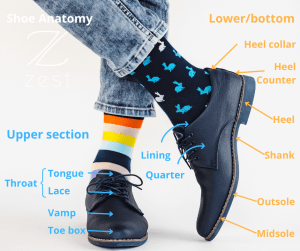What is good footwear?

Good footwear is footwear appropriate for the job you are doing.
What is the purpose of footwear
As a general rule, appropriate footwear protects the foot from the environment. However, gradually over time, footwear became specific to the wearer. This included shoes that were explicitly useful in their functionality and allocated to a particular sport, i.e. football cleats, ballet slippers, and even bespoke medical footwear. As well as providing base support during walking, the foot must be able to adapt to uneven terrain during initial contact. The foot must revert to a rigid structure before leaving the ground. Additionally, the foot joints absorb shock by absorbing transverse plane rotation of the lower extremities. Footwear designed for these functions must stabilise joints and aid shock absorption.
What is a good shoe?
Ideally, when deciding whether a shoe is good for you or not, it should answer the following fundamental questions:
- Does it protect my foot?
- Does it provide enough grip for what I need, i.e. hiking or running?
- Does it absorb shock well?
- Does it provide stability?
- Does it have enough depth for an insole?
- Will it aggravate my foot conditions, i.e. corns, calluses, bunions?
There are seven basic shoe styles: the oxford, the boot, the pump, the clog, the mule, the sandal and the moccasin. In addition, there are a few variations from the non-athletic shoe to an athletic shoe, one being higher.
Understanding the anatomy of the shoe
In a shoe, there are two main sections: the upper, the lower, and their components:
- Upper: the toe box, the vamp, the quarter, the throat, the insole board, and the top line.
- Lower: the shank, the outsole, and the heel.

The components of the shoe
Upper section:
- Toe Box: This is the roofed area of the shoe that covers your toes; the function of the toe box is to allow room for the toes. The height + width of the toe box depends on the type of shoe + activity. Some athletic footwear is designed to allow for an increased range of motion in the big toe joint, such as a tennis shoe used for racquet sports but also used in volleyball due to the repetitive jumping demands of the sport. Some non-athletic footwear allows for extra depth in the toe-box area and deformities such as hammertoes and claw toes.
- Vamp: covers the foot and toe; in athletic shoewear, the vamp is made from one material to reduce rubbing on the top dermal layer of the foot during activities. (less material = less seams) Often in a running shoe, a nylon vamp also has a leather mudguard to reduce debris.
- Quarter: Back half of the shoe contains eye-lets for laces. In an athletic shoe, the vamp and quarter panels are continuous pieces of nylon fabric or leather. More on lacing techniques.
- Counter: The counter is an integral part of the Quarter, used to keep the shoe’s shape and stabilise the hindfoot. Typically, it’s constructed out of fibreboard or heated moldable plastic. An additional piece of leather is externally placed on the counter in an athletic shoe called ‘foxing’. The counter will extend medially in some athletic + non-athletic shoes to stop the foot from pronating. For example, many models of running shoes have this construct, as running extends the period of pronation the foot experiences in a given time.
- Topline/Collar: Refers to the top rim of the quarter. In an athletic shoe, the topline/collar is designed with extra padding and extends above the topline to protect the Achilles tendon during activity. Its purpose is to pull the shoe onto the foot to reduce irritation of the Achilles tendon.
The lower portion of the shoe
- Midsole: This is the surface upon which the foot directly rests; its function is to decrease friction between the foot and the shoe, assist in shock absorption, and absorb sweat. It is made of various materials, including neoprene, nylon, and terry cloth.
- Outsole: This is a protective layer between the plantar surface of the foot and the ground. The qualities of an outsole are durability, flexibility, and traction. Various materials used are thermoplastic rubber and urethanes. The determinant factor for finding an ideal outsole is activity. For activities such as hiking or tennis, the outsole has ripples and grooves for improved traction.
- Shank: refers to the bridge between the heel and the metatarsal heads/ball of the foot. Ideally, the shank should be rigid to prevent the front of the shoe from twisting on the rear; for example, a golf shoe would have a rigid shank, and a ballet shoe would not. A rigid shank is not to be confused with a stiff-soled shoe, as this refers to an inflexible outsole, i.e. powerlifting shoes.
- Heel: This is the bottom rear portion of the shoe and can have varying heights depending on the specific style or functional requirements of the shoe. It developed as a design for women’s shoes rather than as a practical part of the shoe; however, in modern athletic shoes, it is a part that absorbs shock during heel-strike and is durable on long hikes.
Footwear Section
References
McPoil Jr, Thomas G. 1988. “Footwear.” In Physical Therapy, 1857-1865. Vol. 68. https://doi.org/10.1093/ptj/68.12.1857
Contact us
Please feel free to contact reception for more information or to book an appointment with us.

